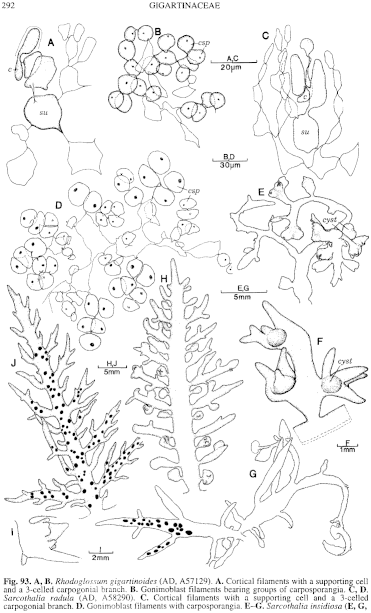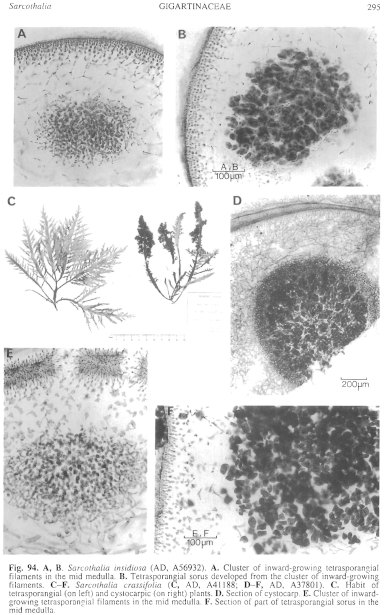|
|
|
|
|
|||||||||||
|
Electronic Flora of South Australia Species Fact Sheet
Phylum Rhodophyta – Class Florideophyceae – Order Gigartinales – Family Gigartinaceae
Synonyms
Sphaerococcus crassifolius C. Agardh 1822: 273; 1824: 224.
Gigartina crassifolia (C. Agardh) J. Agardh 1842: 104
Gigartina crassicaulis (C. Agardh) Setchell & Gardner 1933: 294; 1934: 136. Lucas & Perrin 1947: 151.
Gigartina livida (Turner) Greville sensu J. Agardh 1851: 270; 1876: 196. Harvey 1860a: 325; 1863, synop.: xliii. Hooker & Harvey 1847: 40. Lucas 1909: 24; 1929a: 16. Wilson 1892: 183. [NON G. livida (Turner) J. Agardh 1842: 104 from New Zealand.]
Gigartina pinnata J. Agardh sensu Harvey 1859a, pl. 68. Kützing 1869: 6, pl. 17.
Thallus (Fig. 94C) dark red to brown-red, fading to yellow-brown, 8–30 cm high, slightly mucilaginous and drying cartilaginous with several complanately branched fronds from the holdfast; fronds alternately pinnate, usually relatively bare below with compressed percurrent axes (3–) 5–15 mm broad, tapering to base and apex, 1–1.5 mm thick; marginal laterals similarly pinnately branched, 2–5 mm broad, 0.7–1 mm thick, with pinnules 4–12 mm long and 1–2 mm broad, terete to slightly compressed, with rounded apices; older axes often with surface ramuli. Holdfast discoid, 1–3 mm across, becoming stoloniferous; epilithic. Structure of a dense cortex of anticlinal, subdichotomous, filaments, end cells 0.5–2 µm in diameter and L/D 2–4, and a medulla of slender, anastomosing filaments.
Reproduction: Sexual thalli monoecious. Carpogonial branches 3-celled, borne on relatively large inner cortical (supporting) cells in the ultimate pinnules. Cystocarps (Fig. 93H, I) 1–1.5 mm across, subterminal or marginal in the compressed pinnules, without or with an involucre of 1–3 short ramuli 1–3 mm long, apices rounded to spinous; enveloping tissue compact, with numerous transverse filaments from the gonimoblast, carposporophyte (Fig. 94D) with a filamentous matrix of scattered larger cells with thickened pit-connections and dense clusters of ovoid carposporangia, each 7–12 µm in diameter. Spermatangial sori near or surrounding developing cystocarps, with the outer cortical cells each cutting off two spermatangia which produce ovoid spermatia about 1 µm in diameter.
Tetrasporangial sori (Fig. 93J) ovate to circular, maculate, 0.5–1 (–1.5) mm across, scattered over the lateral branches, with tetrasporangia developed from a cluster of inward growing filaments (Fig. 94E) originating in the mid medulla, with the earlier formed cells transformed into tetrasporangia (Fig. 94F) and some cut off laterally, giving a deep-seated medullary sorus; tetrasporangia ovoid, 20–32 µm in diameter, cruciately divided.
Type from "Nouv. Holl." (from Desfontaines); lectotype ("Fucus Tt") in Herb. Agardh, LD, 23557 (a smaller fragment 23556); and in PC.
Selected specimens: Cape du Couedic, Kangaroo I., S. Aust., low eulittoral (Womersley, 12.i.1948; AD, A7008). Pennington Bay, Kangaroo I., S. Aust., uppermost sublittoral (Kraft & Min-Thein, 1.xii.1971; AD, A41330). Margaret Brock Reef, Cape Jaffa, S. Aust., 10 m deep (R. Lewis, 15.ii.1974; AD, A45028). Cape Lannes, S. Aust., uppermost sublittoral (Womersley, 17.xii.1970; AD, A37801 and 20.xii.1971; AD, A41188 -"Marine Algae of southern Australia" No. 88, and Edyvane, 28.iv.1984; AD, A55437). Blackfellows Caves (S of Carpenter Rocks), S. Aust., upper sublittoral (Edyvane, 3.ii.1984; AD, A55439). Walkerville, Vic., drift (Sinkora A2588, 27.iii.1979; AD, A60999). Eddystone, Tas. (Perrin 726, Nov. 1949; AD, A49700). Eaglehawk Neck, Tas., drift (Wollaston &
Distribution: South coast of Kangaroo I., S. Aust., to Walkerville, Vic., and the east coast of Tasmania, occurring just sublittoral to 10 m deep on rough-water coasts.
Taxonomic notes: Mitchell, 1.iii.1964; AD, A27796). Ninepin Point, D'Entrecasteaux Ch., Tas., at low tide (Edyvane, 15.iii.1982; AD, A53112).
S. crassifolia, like S. insidiosa and S. radula, is characterised by deep-seated medullary sori which originate from a cluster of secondary medullary filaments.
S. crassifolia has relatively thick axes and main branches [1–1.5 mm thick, compared to 500–750 1.1tri in the New Zealand G. livida (Turner) J. Agardh which also has maculate sori], and by the presence of maculate tetrasporangial sori. This contrasts with the elongate, largely marginal, sori of the morphologically similar G. pinnata (see below). Development of the tetrasporangial sori in other related but distinct pinnate New Zealand species has not been recorded.
At the western end of its range, on Kangaroo I., specimens are usually dwarf and less branched, and in some localities (A55437 and A60999 cited above) the branches are relatively slender (2–5 mm broad).
References:
AGARDH, C.A. (1822). Species Algarum. Vol. 1, Part 2, pp. 169–398. (Berling: Lund.)
AGARDH, C.A. (1824). Systema Algarum. (Berling: Lund.)
AGARDH, J.G. (1842). Algae Maris Mediterranei et Adriatici, Observationes in Diagnosin Specierum et Dispositionem Generum. (Fortin, Masson: Paris.)
AGARDH, J.G. (1851). Species Genera et Ordines Algarum. Vol. 2, Part 1, 1–336 + index. (Gleerup: Lund.)
AGARDH, J.G. (1876). Species Genera et Ordines Algarum. Vol. 3, Part 1 - Epicrisis systematis Floridearum, pp. i-vii, 1–724. (Weigel: Leipzig.)
HARVEY, W.H. (1859a). Phycologia Australica. Vol. 2, Plates 61–120. (Reeve: London.)
HARVEY, W.H. (1860a). Algae. In Hooker, J.D., The Botany of the Antarctic Voyage. 111. Flora Tasmaniae. Vol. II, pp. 321–343, Plates 185–196.
HARVEY, W.H. (1863). Phycologia Australica. Vol. 5, Plates 241–300, synop., pp. i-lxxiii. (Reeve: London.)
HOOKER, J.D. & HARVEY, W.H. (1847). Algae Tasmanicae. Lond. J. Bot. 6, 397–417.
KÜTZING, F.T. (1869). Tabulae Phycologicae. Vol. 19. (Nordhausen.)
LUCAS, A.H.S. & PERRIN, F. (1947). The Seaweeds of South Australia. Part 2. The Red Seaweeds. (Govt Printer: Adelaide.)
LUCAS, A.H.S. (1909). Revised list of the Fucoideae and Florideae of Australia. Proc. Linn. Soc. N.S.W. 34, 9–60.
LUCAS, A.H.S. (1929a). The marine algae of Tasmania. Pap. Proc. R. Soc. Tasm. 1928, 6–27.
SETCHELL, W.A. & GARDNER, N.L. (1933). A preliminary survey of Gigartina, with special reference to its Pacific North American species. Univ. Calif Pubis Bot. 17, 255–340.
SETCHELL, W.A. & GARDNER, N.L. (1934). De Gigartinis. Rev. Algol. 7, 131–138.
WILSON, J.B. (1892). Catalogue of algae collected at or near Port Phillip Heads and Western Port. Proc. R. Soc. Vict. 4, 157–190.
The Marine Benthic Flora of Southern Australia Part IIIA complete list of references.
Publication:
Womersley, H.B.S. (14 January, 1994)
The Marine Benthic Flora of Southern Australia
Rhodophyta. Part IIIA, Bangiophyceae and Florideophyceae (to Gigartinales)
Reproduced with permission from The Marine Benthic Flora of Southern Australia Part IIIA 1994, by H.B.S. Womersley. Australian Biological Resources Study, Canberra. Copyright Commonwealth of Australia.
Illustrations in Womersley Part IIIA, 1994: FIGS 93 H–J, 94 C–F.

Figure 93 enlarge
Fig. 93. A, .B. Rhodoglossum gigartinoides (AD, A57129). A. Cortical filaments with a supporting cell and a 3-celled carpogonial branch. B. Gonimoblast filaments bearing groups of carposporangia. C, D. Sarcothalia radula (AD, A58290). C. Cortical filaments with a supporting cell and a 3-celled carpogonial branch. D. Gonimoblast filaments with carposporangia. E–G. Sarcothalia insidiosa (E, G, AD, A56932; F, AD, A16198). E. Branchlets with cystocarps. F. Cystocarps with involucral pinnules. G. Branchlets with attachment haptera and tetrasporangial sori. H–J. Sarcothalia crassifolia (AD, A55439). H. Branch with cystocarps, I. Cystocarp with involucral ramuli. J. Branch with maculate tetrasporangial sori.

Figure 94 enlarge
Fig. 94. A, B. Sarcothalia insidiosa (AD, A56932). A. Cluster of inward-growing tetrasporangial filaments in the mid medulla. B. Tetrasporangial sorus developed from the cluster of inward-growing filaments. C–F. Sarcothalia crassifolia (C, AD, A41188; D–F, AD, A37801). C. Habit of tetrasporangial (on left) and cystocarpic (on right) plants. D. Section of cystocarp. E. Cluster of inward-growing tetrasporangial filaments in the mid medulla. F. Section of part of tetrasporangial sorus in the mid medulla.

|
Email Contact: State Herbarium of South Australia |

|